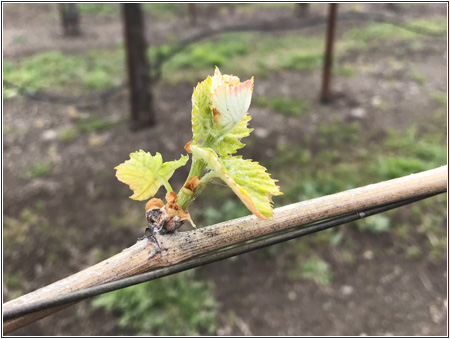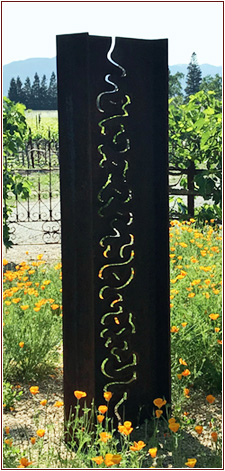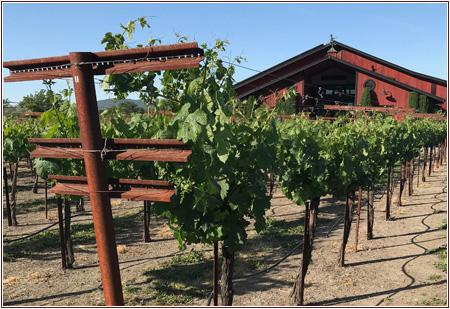
Tom Scott Vineyard Newsletter - Spring 2020 - Barn Burner Cabernet Sauvignon

It seems strange that while so much of the world is experiencing stress and upheaval, our vineyard and gardens are putting on a beautiful show. We so wish you could be here!
 We began pruning February 14th, Valentine's Day, the perfect day to begin a labor of love! This year we finished pruning in late March and the vines took off. Within 30 days we had more than 12 inches of growth! Our evaluation, wood selection and pruning of each vine takes about 4 minutes per plant. We prune together, each working one side of the vine moving through the vineyard as a team, often sharing wood for new canes from one side to the other. Four minutes per plant may not seem like much, but there are approximately 2,050 vines! We began pruning February 14th, Valentine's Day, the perfect day to begin a labor of love! This year we finished pruning in late March and the vines took off. Within 30 days we had more than 12 inches of growth! Our evaluation, wood selection and pruning of each vine takes about 4 minutes per plant. We prune together, each working one side of the vine moving through the vineyard as a team, often sharing wood for new canes from one side to the other. Four minutes per plant may not seem like much, but there are approximately 2,050 vines!
When we begin pruning, the first thing we do is determine how well the vine grew the previous growing season. We look at the bare canes to see how long they are, and based on their length, we decide how many canes we'll leave for this year. If the growth was balanced, having produced canes of 5 to 6 feet, we will cut the vine back to the "standard" length, 4 fruiting canes of 10 buds each. If the canes are short or the growth is stunted, we might reduce the number of canes we leave on the vine, or reduce the number of buds we leave on the canes. We might only leave 2 or 3 canes with the buds on each cane reduced to 8. If the growth is overly vigorous, canes from 6 to 15 feet, we will prune to slow the vine down, to bring it back into balance this year. We slow excessive growth by adding an additional cane, adding 16 to 20 additional buds to the vine. This cane is called a "kicker" cane.
 This year we had many vines that we added kicker canes to, sometimes adding more than one additional cane on a single plant! The vigor of the vineyard is amazing. The vines are 20 years old in the west block and 14 years old in the east block, and they are clearly just getting started! This year we had many vines that we added kicker canes to, sometimes adding more than one additional cane on a single plant! The vigor of the vineyard is amazing. The vines are 20 years old in the west block and 14 years old in the east block, and they are clearly just getting started!
We're often asked how long a vine will live and produce well; our answer is in our vineyard... time will tell, we have no idea. Every vineyard is unique, offering different soil profiles, different access to water, different row and vine spacing, different trellising. We can only speak to this property and these vines.
Our vine rows are spaced 9 feet apart, to allow a tractor to easily navigate the field. The vines are spaced 5 feet apart, to allow canes from neighboring vines to meet in the middle. The trellising system is a modified "open lyre." That allows the canes to be supported while allowing light and airflow to the center of the "head." Tom's modification of the trellising system is an extra set of high wires added to protect the canes from the wind.
The vines are "head-trained" and cane-pruned. Each plant grew to approximately 4½ feet and then we "topped" it, creating the permanent head. Each pruning season we choose 4 of last year's canes; we cut them to length leaving 10 buds on each and carefully wrap them around the lowest wire on the trellis, the fruiting wire, this wire will help support our primary fruit.
We have deep groundwater on our property and we also have wells. The groundwater is very deep, and both the aquifer and wells have been unaffected by the severe droughts we've experienced in the past. The roots of our vines can extend 40 feet or more, easily accessing the water. In the last few years as the vines have reached that water, we have watched in amazement as the vines have responded with additional structural growth and vigor.
 This year kicker canes were added to more vines, and in more locations than ever before. A kicker cane on an end plant is not that unusual, as they tend to get more sun and don't have a neighboring vine competing for root space. But now for the first time, we have kicker canes on vines throughout the field. Clearly. they've found the aquifer! This year kicker canes were added to more vines, and in more locations than ever before. A kicker cane on an end plant is not that unusual, as they tend to get more sun and don't have a neighboring vine competing for root space. But now for the first time, we have kicker canes on vines throughout the field. Clearly. they've found the aquifer!
Our variety of soil types is called a Bale Series, which is stratified, gravelly and sandy alluvium from mixed sources. Bale soils are on nearly level to gently sloping alluvial fans and terraces. We have lots of rocks, big and small, some on the surface, some hundreds of feet down. The rocks help keep the soil open, which allows the roots to expand.
This vineyard, like every vineyard is unique - it's true that there's no place like TSV!
Our morning walks, working in the vineyard and gardens, evening wine, all help keep us in balance. We hope in these challenging times you and your loved ones are also finding balance. We know this particular "Notes" is long, but we figured, by now you might need something interesting to read.
We have been sending out weekly "cartoons" of Tom, being Tom. If you 've received them, we hope they have made you smile. We're gratified by the number of people that have let us know they like them, and we appreciate those of you that refrained from letting us know you didn't!
We miss your company, sharing our vineyard and wine, and those convivial tastings around the dining room table. We look forward to a time when you will come to visit us again!

At the end of the day, raise a glass to love, and getting it done - that's what we do!
Tom and Lauren Scott
www.tomscottvineyard.com
www.tomscottvineyard.com/wineshop
info@tomscottvineyard.com
Back-issues of our Notes

|



